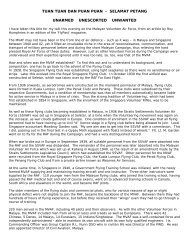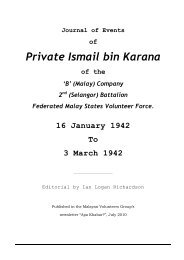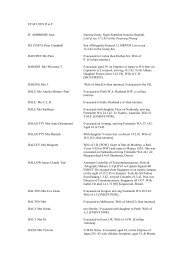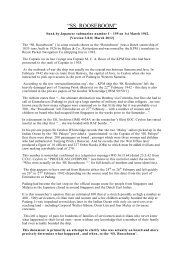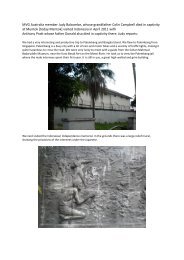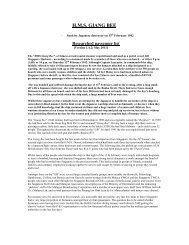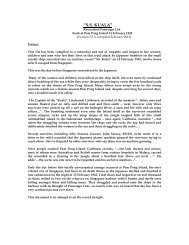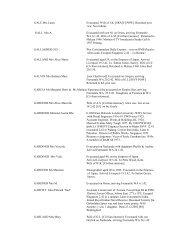SINGAPORE AND THE THAI RAILWAY EXPERIENCES OF ...
SINGAPORE AND THE THAI RAILWAY EXPERIENCES OF ...
SINGAPORE AND THE THAI RAILWAY EXPERIENCES OF ...
You also want an ePaper? Increase the reach of your titles
YUMPU automatically turns print PDFs into web optimized ePapers that Google loves.
at all. The colour of their skins did not make a great deal of difference to their status as<br />
Dutch. Under Dutch law any person with any European Dutch blood became a Dutch<br />
subject with all attendant advantages. There was the usual sense of inferiority amongst the<br />
Eurasians but I was surprised to find that, on the whole, they were better educated and more<br />
cultured than their fellow white Dutch. I think this was due to the high standard of advanced<br />
education in Java. Nearly all of their schools taught English as a compulsory subject whereas<br />
in Holland<br />
English was a language taught after German and French, which were the two compulsory<br />
languages.<br />
Other high lights of Nakon Phatom<br />
40.<br />
Page 73<br />
The Canteen This was the best I came across as a POW. The management of it was largely<br />
Volunteer and many of my friends had jobs there. Needless to say they were good jobs and<br />
much sought after. The canteen staff used to get all the best food and they were paid in<br />
addition. Although things became more difficult to get at the end of 1944, due to the shortage<br />
of transport on account of Allied bombing, we were usually able to buy:-<br />
Eggs (fried or boiled) at 12 ½ cts to 15 cts.<br />
Bananas at 1 ct each<br />
Peanuts at 10 cts a ¼ pint<br />
Peanut toffee at 15 cts a piece 3" x 2 ½"<br />
Fried Fresh Fish at 15 cts each, the size of herrings.<br />
Tapioca flour bread at 10 cts a piece 1 ½" x 3" x ½"<br />
Chili sambal at 5 cts a tablespoonful.<br />
Page 74<br />
These prices were not too high considering what they had to pay in Malaya at the same period<br />
- $10.00 for one egg, and so on. We were paid 25 cts a day by the Japanese so one could buy<br />
one egg and one piece of bread each day, that is if one was earning money by working. I did<br />
not work much at Nakon Phatom but, by selling my cigarette case for $18.00, changing $40<br />
Japanese Malayan currency into $80.00 Siamese, I usually had enough money to buy 2 eggs a<br />
day. One could safely say that everyone in the camp averaged 1 to 2 eggs each day, which<br />
made all the difference to their health.<br />
The water Up the river when working on the railway we used to drink river water, which<br />
during the rainy season was thick with mud and sand.<br />
Page 75<br />
I am sure the bad water contributed largely to the intestinal complaints of the POWs. At<br />
Nakon Phatom all the water came from deep bores - about 250 deep. We put these bores<br />
down soon after we arrived and the quality of the water was excellent. The food was<br />
consequently much better cooked and the tea quite palatable. About Nov. 1944 we even had<br />
bath water from these bores. Each day every man in camp got 3 gallons of washing water.<br />
The result of this was that skin diseases got better. There had been a lot of ringworm, scabies,



